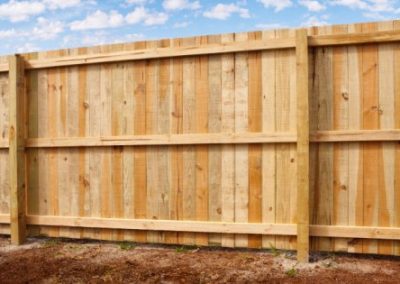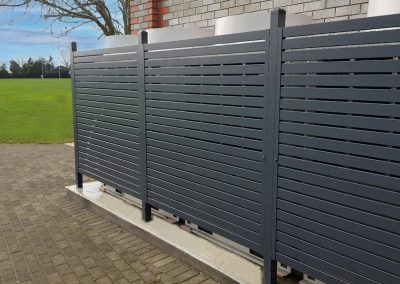I recently heard a saying: fences make good neighbors. This came about as a friend was describing the dispute that has resulted with her neighbouring homeowner over a proposed new fence. It sounds to me like they’re ‘neighbours at war’ and potential candidates for a reality TV show of the same title.
The good news is, it doesn’t need to get to this!
Neighbourly Intentions
The process of planning, design, choosing the materials and constructing your new fence can be challenging for your neighbours, especially when they have to agree on everything, including the cost which is shared. However, once the fence is built, the neighbors can enjoy the benefits as well, including safety and privacy.
Plus, if you’re fully fencing your property (house and land) this not only adds value to your home but is a win-win for both sides of the fence!
Let’s look at some of the challenges with building residential fences, including choosing fence materials.
Be Informed
Before commencing your project, it’s important to understand the legalities of a) doing any work to the shared fence/boundary, and b) sharing the cost of your fence with your neighbour.
There are government and council rules and regulations in place for your region including how high your fence can be and where you’re able to erect your fence – you don’t want to build on your neighbor’s property without approval as this could lead to a dispute and the fence needing to be moved at your cost!
A surveyor will let you know exactly where the boundary between your properties is and the ideal fence line.
Cost
The cost of your project usually dictates everything from design, height and length of the fence. Thankfully, you can get inspiration from other homes nearby or even check free online resources. Look for an online cost calculator so you can get an estimate of the investment required.
Most suppliers of fencing material have products available to view and most fencing manufacturers have showrooms and online galleries showcasing different fencing projects. You can make use of those as a guide for choosing the best fence for your home and if you want to make the fence project a true collaboration with your neighbour perhaps invite them to the showroom too.
When buying from a manufacturer or fencing company you’ll find they’ll have installers in your area that are able to quote for the installation of their products, that’s if you dont want to do it yourself. With more bespoke fences, builders are able to quote to supply and/or install subject to the length, height, terrain/land and materials used.
Once you have selected your style of fence shop around for a quote from the wide range of manufacturers supplying in New Zealand. We recommend obtaining a couple of quotes and sharing these with your neighbour before settling on a supplier. Transparency and consultation will be key throughout this process.
Fencing Materials
In terms of materials, there are many different types available for both commercial and residential fences. However, in this post we’ll focus on the more common.
Wood
Using a natural, sustainable material like natural wood is a popular choice, and there are many different types of wood to bring your vision to life.
We recommend choosing a hardwood like Kwila, so your new build it stands the test of time. Softwoods are cheaper for a reason. Take pine for example. These grow quicker, are milled faster and are ready for sale while the wood is not fully dry. Over time the wood will dry out and shrink up to 20 per cent, so watch the gaps between the planks as they will increase over time.
Softwoods cost less so when it comes to sharing costs your neighbors will likely elect for the cheaper material. Be prepared to pay the difference if you want a to have quality hardwood which will also provide a better aesthetic.
Pros of wooden fences
- Affordable pricing across a wide range of types and styles
- Customisable and easy to work with
- Renewable resource
- Warm aesthetics
Cons of wooden fences
- Ongoing maintenance is required to protect against the weather, rot and pests
- Lower quality and untreated wood fences are prone to deterioration
- Flammable material
Composite and Vinyl
Plastics are used everywhere, so why not for fences too! The good news is they last a very long time. Plus, vinyl fences can look like wood however, they are made of PVC. They are low-maintenance, excellent in bad weather like wind, rain, snow, and there are affordable options, especially if you choose a picket fence design.
Composite fences offer you a more sustainable alternative to milled timber fencing, and enables decks, gates and fences to combine into one integrated design. With a range of colours and textures available this alternative wood product is well worth the investment.
Pros of composite fencing
- A low-maintenance choice that does not require painting or fencing
- A durable option, resistant to rot and decay
- An eco-friendly choice made nearly entirely from recycled materials
- Wide range of colour options and styles
Cons of composite fencing
- Can be slightly more expensive than some timber alternatives
- The faux wood look isn’t for all
- Can expand and contract with dramatic temperature changes
Aluminium and Steel
Aluminium is strong and durable yet light and easy to transport and install. Perfect for use around pool areas and in the garden, aluminium is long lasting and rust free. Simple to install, Aluminium normally arrives in pre-made fence panels that attach to aluminium fence posts.
Steel fencing is also strong, stable, and made to withstand the elements. Solid steel fence panels provide plenty of privacy whilst slat-style panels allow for natural light penetration.
Pros of aluminium fencing
- A contemporary choice that’s great for modern kerb appeal
- Durable and will not rust making it ideal for coastal locations
- Lightweight and versatile, available in a wide range of colours
- Low maintenance and is a recyclable material
Cons of aluminium fencing
- Has a higher upfront cost
- Installation can be challenging
- Not quite as strong as some other metal fencing options
So there you have it…
Building a fence between properties is a collaborative process and should involve both sides of the fence along the way. Fences add value to homes and while there will be some upkeep the positives for having them far outweigh any negatives.
If you’re interested in glass fencing solutions for decks, pools, stairs and patios we’ll share more on this next month right here on the Lockhart Construction blog.
Contact us today to start planning your next renovation project and transform your home into a space you’ll love for years to come!




